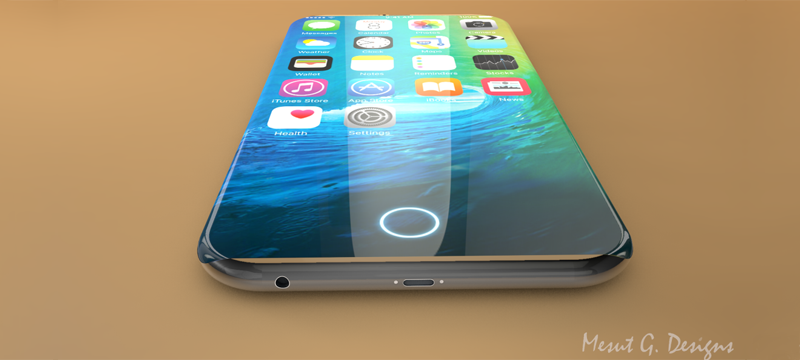Submitted by Frank Macey on
As usual several reports from the supply chain and analyst sources are looking towards Apple's next generation of iPhones. First in line is new information about a metal iPhone 6c to be released early next year. The launch of this 4-inch iPhone upgrade marks a departure from Apple's annual refresh cycle. Speaking of which, the 5.5-inch iPhone 7 is expected to drop in September 2016 with a bevy of enhancements and an even thinner design. The concept above from Mesut G. Designs is loosely based on recent reports, featuring a 3D Touch home button embedded under the display itself.
Internal Hardware
The iPhone 6s has 200% more RAM than its predecessor, and Apple is expected to up this number again. The iPhone 7 is reported to contain 3 GB of RAM, which is 1.5 times the amount found in current generation iPhones. The additional RAM will be included with the next generation Apple A10 processor, which will improve CPU and graphics performance. Apple will likely update the motion coprocessor and other components with an eye on speed. Apple sources the current model A9 system from two suppliers, Samsung and TSMC.
One report points to Apple abandoning the 3.5mm headphone jack in the iPhone 7. Instead, audio would be delivered via the Lightning connector to compatible headphones or through an adapter. If Apple makes this change, the iPhone 7 could be significantly thinner, or it could pack a larger battery. The drawback would be that standard wired headphones would require an adapter to connect.
Waterproofing
While the current iPhone 6s and iPhone 6s Plus are not waterproof, several design changes have increased the water resistance of these devices. For example, a rubber gasket around the case seam and sealed chip assemblies are practically waterproof. However, the speakers, microphone and ports are not waterproofed. Apple looks on track to fully waterproof and dust proof the iPhone 7, as reports indicate the company is already testing prototypes of this type. Another contribution to waterproofing could be a system-in-package design for the A10 processor, modeled after the water-resistant S1 found in the Apple Watch.Embedded Touch ID
Apple continues to improve and refine Touch ID technology, and the components coming to the iPhone 7 will continue this trend. Some reports show a Touch ID sensor that is actually embedded below the front display glass. This would be a radical departure for the iPhone home button, which has been a fixture on Apple phones since the very beginning.
Display
Newest iPhone FAQs
The advantages of AMOLED technology have been listed before, thinner profile, lower power consumption, and more accurate color reproduction. Apple has been rumored to be investigating OLED displays in the past, however the only Apple device currently using this display type is the Apple Watch. That could all change in the future. Current reports point to 2018 as the year that AMOLED displays may hit the iPhone, a few more iterations ahead of next year's iPhone 7.
Other rumors circling around the display involve a significantly reduced bezel size, with some even expecting the iPhone 7 screen to go completely edge-to-edge. The front of the upcoming device is reported to be flat as well, without the curved bezel seen on the iPhone 6s.
Camera
Dual cameras are nothing new in the world of iPhone rumors. As of yet, Apple has not taken the plunge with any 3D photography or other uses for a dual-camera setup. While these rumors have resurfaced again regarding the iPhone 7, it is unlikely Apple would go this route next year. Other evidence, such as patents point to optimized lenses and other space-saving features for the iPhone camera.
For the latest iPhone 7 news, follow the iPhoneFAQ on Twitter and connect with us on Facebook.
